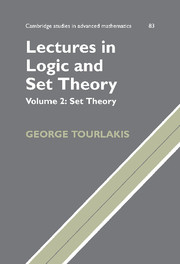II - The Set-Theoretic Universe, Naïvely
Published online by Cambridge University Press: 12 January 2010
Summary
This volume is an introduction to formal (axiomatic) set theory. Putting first things first, we are attempting in this chapter to gain an intuitive understanding of the “real” universe of sets and the process of set creation (that is, what we think is going on in the metatheory). After all, we must have some idea of what it is that we are called upon to codify and formally describe before we embark upon doing it.
Set theory, using as primitives the notions of set (as a synonym for “collection”), atom (i.e., an object that is not subdivisible, not a collection), and the relation belongs to (∈), has sufficient expressive power to serve as the foundation of all mathematics. Mathematicians use notation and results from set theory in their everyday practice. We call the sets that mathematicians use the “real sets” of our mathematical intuition.
The exposition style in this chapter, true to the attribute “naïve”, will be rather leisurely to the extent that we will forget, on occasion, that our “Chapter 0” (Chapter I) is present.
The “Real Sets”
Naïvely, or informally, set theory is the study of collections of “mathematical objects”.
Informal Description (Mathematical Objects). Set theory is only interested in mathematical objects. As far as set theory is concerned, such objects
are either
atomic – let us understand by this term an object that is not a collection of other objects – such as a number or a point on a Euclidean line, or
collections of mathematical objects.
- Type
- Chapter
- Information
- Lectures in Logic and Set Theory , pp. 99 - 113Publisher: Cambridge University PressPrint publication year: 2003



